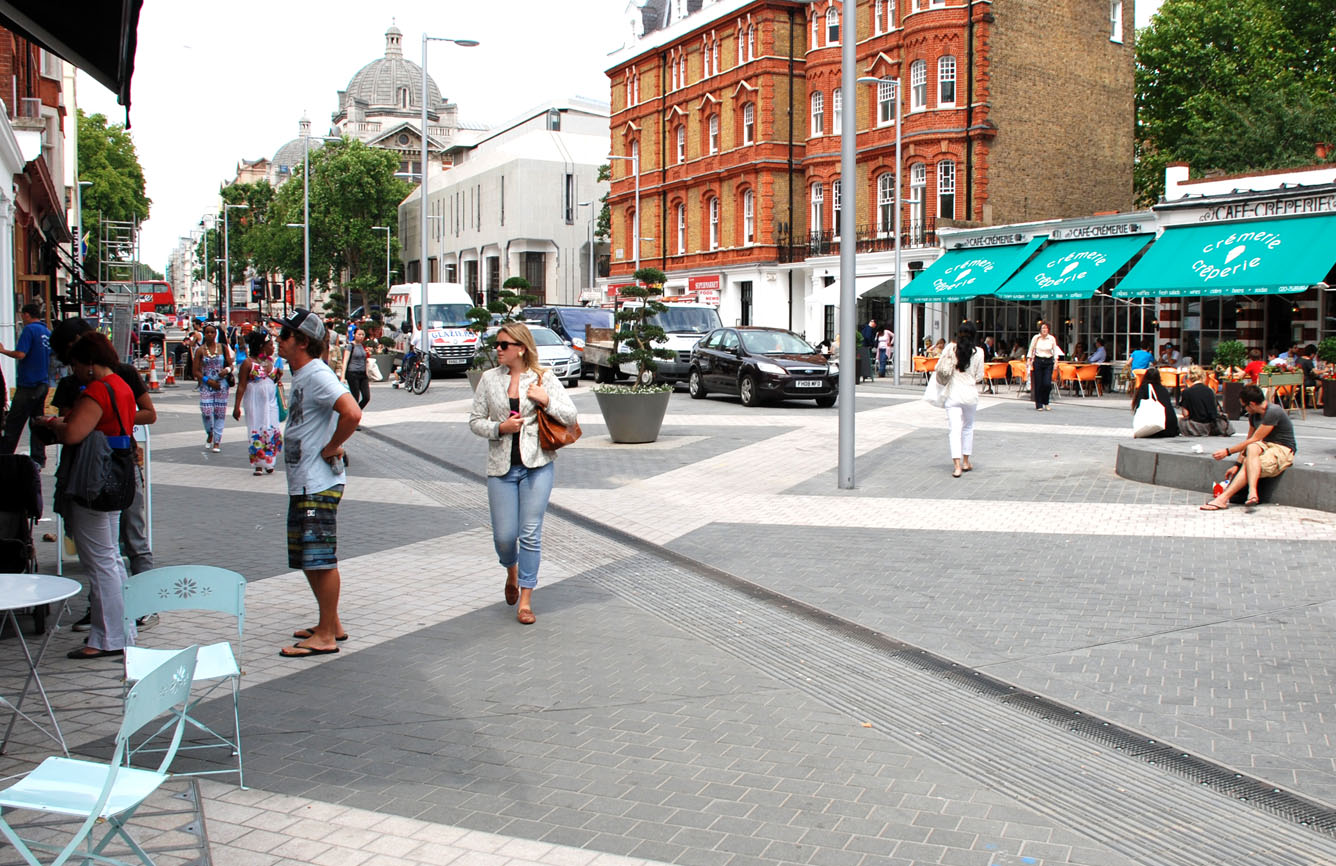Happy 10 Year Anniversary Exhibition Road! If you’ve ever had a day out at the Natural History Museum, you’ve walked down this iconic road. The road is actually over a hundred and needed improvements including enhancements to the design to reflect its significance. 10 years ago, we set out to do just that.
Overview
Exhibition Road extends from South Kensington Underground station in the south to Hyde Park in the north. It is home to some of Britain’s most important institutions including the Victoria and Albert Museum, the Natural History Museum, the Science Museum and Imperial College. Since 1851, Exhibition Road has been a major destination for those interested in the arts and culture. The area attracts over 11 million visitors each year.
The old road layout around the underground station was a one-way system dating from the 1960s. We saw it was difficult for pedestrians to cross and cluttered and unappealing in appearance. The old layout of Exhibition Road itself had three rows of parked cars (two kerbside and one in the central median), two vehicle running lanes and pavements too narrow to cope with the large numbers of visitors. The public realm was filled with street clutter and vehicular traffic. This made it unpleasant and sometimes hazardous to visit on foot. We found that the area was not an attractive setting for its prestigious institutions.
Active Travel
The design replaced a street filled with clutter and vehicular traffic with a fully accessible kerb-free public space. Pedestrians could enjoy walking from South Kensington Station to Hyde Park along a space that befits the magnificent surrounding buildings.
The one-way system around South Kensington station was unravelled and through traffic removed from the southern section of Exhibition Road. Access to key routes are more direct, bus journey times quicker and created a much better environment for pedestrians. The area is one that now encourages explorative walking and browsing. There are also numerous cycle parking racks and two Barclay’s Cycle Hire docking stations.
Safety
The busiest section of Exhibition Road for pedestrians has always been around the museums. We added a four metre wide corridor from the buildings on the western side as a safe area for pedestrians. This was beside an eight metre ‘transition zone’ where pedestrians walk while safely accommodating parking bays, cycle racks and seating. This includes two lanes for traffic and a four metre ‘safe pedestrian zone’ on the eastern side of the road.
Having a less distinct ‘track’ for through traffic makes motorists drive more cautiously with greater awareness and consideration for pedestrians. The diagonal grid pattern reflects the way pedestrians use the road, crossing between one institution and another. The pattern acts as a discouragement to the conventional linear movement of streets.
The lighting scheme included 26 bespoke lighting masts spaced 25 metres apart from Kensington Road to Cromwell Road. The 20 metre high, slender columns acted as a sculptural feature to complement the grand buildings around them. Each lighting mast incorporates three types of light source. Low level lighting animates the ground plan for pedestrians and a middle section provides street lighting for vehicles. An on top accent light gives a sense of direction to the street as a whole. This creates visual diversity and interest as well as ensuring high visibility for pedestrians and road users.
Sustainability
The new traffic levels on the road are significantly reduced with vehicles restricted to a single carriageway and a maximum speed of 20mph. Existing mature trees were retained and augmented with new sustainably resourced trees to maintain the character of a tree lined boulevard.
Investment in high quality materials and building the road to high construction standards together with the use of natural stone and tight specifications means that the surface will last for generations to come and never need resurfacing.
Inclusivity
We replaced kerbs, barriers and street clutter with a kerb free surface across the road allowing pedestrians to move freely. This includes those using wheelchairs, push chairs and mobility scooters. Pedestrians now have more space and motorists drive more cautiously and slowly, with greater awareness and consideration for pedestrians.
Black cast iron drainage channel covers were installed along each side of the road to mark the ‘safe pedestrian’ areas. Alongside the drainage channel, wide strips of specially designed ‘corduroy’ warning tactile paving were used. This, together with the drainage channel covers, provides clear signals for blind, partially sighted people and young children that these areas are vehicle-free so they can use Exhibition Road with confidence.
Impact
Directly after implementation, the café sector of the scheme saw increased numbers because of the improved environment. We saw increased number of chairs and tables on the pavement, doubling capacity, which benefits local business owners and pedestrians
In 2018, we saw a survey undertaken to determine how successful the scheme had been and what improvement there could be.
The survey shows a high number of gaps recorded in traffic greater than six seconds. This indicates many opportunities for pedestrians to cross. Opportunities to cross are particularly important for a road such as Exhibition Road. This is because of the lack of dedicated crossing facilities that would be present on a more traditional street with such high foot traffic. When pedestrians do cross, the survey finds that the majority cross through no traffic with a 59% increase in crossing since the initial survey in 2013.
Feedback
We completed the project in December 2011. We saw acclaim with the Evening Standard’s headline ‘Exhibition Road an ‘exemplar’ of how to make a city liveable’ as quoted by the judges for winning the architectural excellence award by the Royal Institute of British Architects.
The scheme won several awards including ICE Community Award 2012, LTA Excellence in Walking and Public Realm Award 2012 and New London Award Place Making Unbuilt 2011 with special mention in the European Prize for Urban Public Space 2012 and runner up for LGN Street Design Public Lighting award.
Find out more about what we offer here: https://www.marstonholdings.co.uk/projectcentre/landscape-urban-design/







